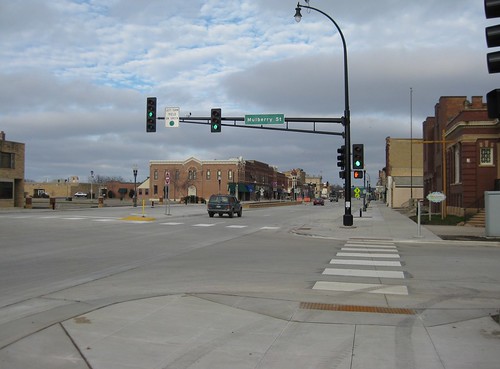One of the more challenging issues facing Main Streets in Minnesota is situations where that Main Street is also a Minnesota Trunk Highway. For most small towns, the designation of their Main Street as a Trunk Highway is bittersweet. Sweet, because it means the city is probably located along a trade route (or former trade route) deemed important enough for the roadway to be a Trunk Highway, which means that there will be non-residents passing through that may stop and spend money at local businesses. Also because it means there are additional pools of money available for maintenance or improvements to that roadway. Bitter, because it means the City may also have to endure the traffic from folks passing through that have no interest in stopping and just end up speeding through town on their way to somewhere else. Also, it means that the city doesn’t really have control over their own Main Street – the City can’t make any improvements without MnDOT’s approval.
[Edit 1:20 PM- one commenter referred to the Municipal Consent laws that require cities to give approval to anything MnDOT wants to do to a roadway as well. This is important, and establishes a balance of power of sorts. The purpose of this statement is only to point out that if a small town wanted to implement changes to their Trunk Highway Main Street that they believed would improve the Main Street, they are not empowered to do so on their own, and can only do so with MnDOT’s approval, which may or may not be obtained, depending on the circumstances and the proposed changes.]
This works out well for some Cities, not so well for others. A lot depends on whether the roadway treats a particular City’s Main Street as a valuable destination, or more of an obstacle that drivers will face on their way between other destinations. Roadway designs often send some pretty clear messages about whether drivers are expected to pass through town quickly without stopping or slow down to interact with the surrounding community. Other times, these messages are subtle. Of course, in all cases, some drivers want one thing, some drivers want the other.
Trunk Highways and Main Streets are an awkward combination, no matter how you look at it. Trunk Highways exist to link destinations, to provide routes for heavy trucks and freight movement, and to provide high-speed mobility between destinations. Main Streets, by definition, are a collection of destinations within close proximity. Main Streets exist to provide convenient access to these destinations. A roadway will rarely do both of these things well. When demands for mobility and accessibility are placed on the same roadway, both sides usually end up compromising, and sometimes, nobody wins.
The City of Ely’s Sheridan Street (TH-1, US-169) is a good example of a “destination” Trunk Highway Main Street, and it has fared pretty well from the situation, in my opinion.
I’m not holding up Sheridan Street as a best-case scenario, but I think it is one of the better Main Streets in the State. It’s a two-lane, 30 mph roadway, with permitted parking and frequent intersections (~350′ o.c.), and a relatively active Main Street (even if a bit touristy, and only during the Summer). Traffic here is generally pretty calm. I attribute the good fortune of Sheridan Street primarily to two factors:
1) Ely is an end-of-the line destination simply based on it’s location. If you’re driving on this street, your destination is probably somewhere in or around Ely. It’s not a through-route to anywhere.
2) Traffic Volumes have probably never been high enough to warrant anything else.
But, for every end-of-the-line town on a Trunk Highway that isn’t facing congestion issues, there are probably a dozen other towns in the opposite situation. They are located between two larger destinations, and their Main Street is actively feeling stretched to provide both mobility and accessibility at the same time.
St. Peter’s Minnesota Avenue is an interesting case study of a Trunk Highway Main Street facing a bit of an identity crisis. For some, it’s a lively historical business corridor and traditional Main Street. For others, it’s a frustratingly slow 35 mph zone that forces them to slow down as they travel between Minneapolis and Mankato. For most, it’s probably both, depending on the circumstances. Minnesota Avenue was reconstructed in 2009, and it is often held up as a good example of how Trunk Highways and Main Streets can coexist.
What do you think about Trunk Highway Main Streets? Can Trunk Highways and Main Streets coexist? What do you think are the biggest challenges to these dual-purpose roadways? How can Minnesota or MnDOT improve the policies that govern how these streets look, feel, or operate? Are there any examples of best-case Trunk Highway Main Streets that should be held up as an example to emulate? Any worst-case scenarios? What do you think of the 2009 recent reconstruction of TH-169 in St. Peter?


